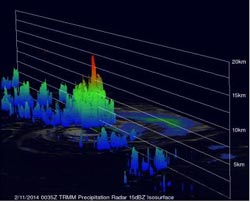NASA still sees some high thunderstorms in Tropical Cyclone Fobane

This is a simulated 3-D view using data from TRMM's Precipitation Radar instrument. It shows a few powerful storms near Fobane's center were reaching heights of over 14km (~8.7 miles) on Feb. 11.<br><br>Credit: SSAI/NASA, Hal Pierce<br>
The Tropical Rainfall Measuring Mission or TRMM satellite passed over Fobane on February 11, 2014 at 0035 UTC. Fobane was very small but contained a few powerful convective thunderstorms near the tropical cyclone's center of circulation. TRMM's Precipitation Radar (PR) measured rain falling at a rate of over 68 mm/~2.7 inches per hour.
TRMM's Precipitation Radar (PR) instrument data was used to create a 3-D image of the storm. Those data found a few of the powerful storms near FOBANE's center were reaching heights of over 14 km/~8.7 miles.
At 0900 UTC/4 a.m. EST on February 11, Fobane's maximum sustained winds had dropped to 45 knots/51.7 mph/83.3 kph. Fobane was far from land areas and centered near 24.5 south and 66.9 east, about 602 nautical miles/692.8 miles/1,115 km east-southeast of Port Louis, Mauritius. Fobane is moving to the south-southwest at 9 knots/10.3 mph/16.6 kph and is expected to continue weakening.
The Joint Typhoon Warning Center expects Fobane to dissipate over the next day or two.
Media Contact
More Information:
http://www.nasa.govAll latest news from the category: Earth Sciences
Earth Sciences (also referred to as Geosciences), which deals with basic issues surrounding our planet, plays a vital role in the area of energy and raw materials supply.
Earth Sciences comprises subjects such as geology, geography, geological informatics, paleontology, mineralogy, petrography, crystallography, geophysics, geodesy, glaciology, cartography, photogrammetry, meteorology and seismology, early-warning systems, earthquake research and polar research.
Newest articles

High-energy-density aqueous battery based on halogen multi-electron transfer
Traditional non-aqueous lithium-ion batteries have a high energy density, but their safety is compromised due to the flammable organic electrolytes they utilize. Aqueous batteries use water as the solvent for…

First-ever combined heart pump and pig kidney transplant
…gives new hope to patient with terminal illness. Surgeons at NYU Langone Health performed the first-ever combined mechanical heart pump and gene-edited pig kidney transplant surgery in a 54-year-old woman…

Biophysics: Testing how well biomarkers work
LMU researchers have developed a method to determine how reliably target proteins can be labeled using super-resolution fluorescence microscopy. Modern microscopy techniques make it possible to examine the inner workings…





















